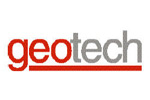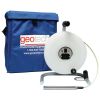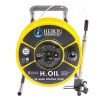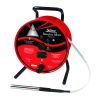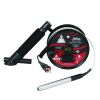Geotech Oil/Water Interface Probes With Float
Features
- Audible & visible alarms activated on reel when probe contacts product & water
- Highly accurate Tefzel coated steel tape marked in engineering or metric increments
- Extremely durable polypropylene storage reel with rugged aluminum frame
- Free ground shipping
- Expedited repair and warranty service
- Lifetime technical support
- More
Overview
The Geotech Interface Probe With Float is a portable reel-mounted instrument that provides measurements of liquids lighter and heavier than water. When the Interface Probe is lowered down a well and contacts the product layer, a solid tone and red light alarm is activated at the reel. When the probe detects water, the tone begins to oscillate and the light changes to green.
Mechanics
The durable storage reel is made from polypropylene with a rugged aluminum frame. The probe consists of a stainless steel and FEP probe attached to a reel-mounted, Tefzel-coated engineer's tape. The engineer's tape comes in engineering or metric increments and is accurate to 1/100 of a foot. The probe has a float that detects hydrocarbon levels and a pair of stainless steel contacts for sensing conductive fluids. The Interface Probe includes a padded carrying case and tape guide.
- (1) Interface probe with float
- (1) Carrying case
- (1) Tape guide
- (1) Operations manual
In The News
Wildfire Prevention in the Sierra Nevada Region with the Yuba Watershed Institute
Though recent wildfires have sparked new conversations about wildfire management and response, groups like the Yuba Watershed Institute have been monitoring the forests and water resources of the Sierra Nevada region for decades, managing approximately 5,000 acres of land with the Bureau of Land Management (BLM) and about 7,000 acres in private land partnerships. The goal of the Institute is to work with local communities and land agencies to improve watershed and forestry management through informed practices and public outreach. The goals of the Yuba Watershed Institute are three-fold: Improve the ability of fire suppression agencies like the California Department of Forestry and Fire Protection ( CAL FIRE ) and the US Forest Service.
Read MoreWave Sensors Integration with NexSens Buoys: A Cutting-Edge Solution for Wave Measurment
Real-time wave data supports accurate weather prediction, safe and efficient maritime operations, and provides valuable safety and operating condition information for recreation and commercial fishing. Understanding wave dynamics also helps with the design of protective coastal structures like seawalls, breakwaters, and jetties. It also supports better prediction of their impact on sediment transport and coastal geomorphology. Wave data is a key factor in qualifying and designing offshore wind farms and harnessing kinetic energy for electrical generation. It helps with the understanding of ocean-atmosphere interactions and contributes to studies of sea-level rise and climate change impacts.
Read MoreSpring 2025 Environmental Monitor Available Now
In the Spring 2025 edition of the Environmental Monitor, we highlight partnerships across the world and the importance of collaboration between government agencies, universities, environmental groups, local communities, and other stakeholders. From great white shark research in Cape Cod to monitoring fisheries in Lake Erie, this latest edition underscores partnerships that connect stakeholders in a watershed through environmental data. With an emphasis on data sharing, a combination of real-time and discrete sampling keeps the public and partners informed of environmental conditions. Our writers also sought out science professionals dedicated to working with peers within and outside of the environmental sector.
Read More




